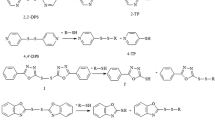Summary
The specifity of Ag+ ions for protein SH groups has been questioned frequently, even though the amperometric titration with AgNO3 is one of the most common methods for the determination of SH groups in proteins. This is due to the fact, that the formation of silver complexes in the titration of cysteine causes a consumption of AgNO3 which is too high. In order to find out if this may be true in the case of proteins, in the present work selected proteins with a well known content of SH and SS groups have been titrated amperometrically in tris buffer pH 7.4 with 0.001M AgNO3. The proteins used were hemoglobin, bovine serum albumin, ovalbumin, lysozyme, pepsin, myoglobin, and cytochrome c. The direct and the indirect titrations of (a) native, (b) denatured, and (c) NaBH4 reduced proteins showed, that the expected consumption of AgNO3 was in no case exceeded. Therefore under the conditions used AgNO3 may be considered as a specific reagent for protein SH groups. High SH values as a result of the amperometric titration of proteins with silver nitrate, which have been published occasionally, may be due to incorrect estimation of the end point of the titration. The reducibility of SS groups depends on the kind of protein. Lysozyme and pepsin were already completely reduced at 23° C, whereas bovine serum albumin needed 60° C. The direct titration method was useful only in some cases for the detection of all SH groups originally present in the proteins or formed by reduction with NaBH4. On the other hand the indirect titration method gave maximum values, because the slowly reacting SH groups of proteins are also allowed to react and the resulting titration curves may be evaluated correctly.
Zusammenfassung
Obwohl die amperometrische Titration mit AgNO3 zu den am häufigsten angewendeten Methoden zur Bestimmung von SH-Gruppen in Proteinen gehört, wird die Spezifität von Ag+-Ionen für Protein-SH-Gruppen in der Literatur vielfach angezweifelt. Dabei geht man von der Tatsache aus, daß Cystein bei der Titration infolge Komplexbildung einen zu hohen AgNO3-Verbrauch verursacht. Um zu prüfen, ob ein unspezifischer Mehrverbrauch auch bei Proteinen eintritt, wurden in der vorliegenden Arbeit ausgewählte Proteine, die (a) nur SH-Gruppen, (b) sowohl SH- wie SS-Gruppen, (c) nur SS-Gruppen und (d) weder SH- noch SS-Gruppen enthielten, mit 0,001 m-AgNO3-Lösung in Trispuffer pH 7,4 amperometrisch titriert. Eingesetzt wurden: Hämoglobin, Serumalbumin, Eialbumin, Lysozym, Pepsin, Myoglobin und Cytochrom c.
Die direkte sowie die indirekte Titration der (a) nativen, (b) denaturierten und (c) mit NaBH4 reduzierten Proteine ergab, daß der theoretisch zu erwartende Verbrauch an Ag+-Ionen in keinem der untersuchten Fälle überschritten wurde. AgNO3 ist somit unter den gewählten Bedingungen durchaus als spezifisches Reagens für Protein-SH-Gruppen anzusehen. In der Literatur gelegentlich mitgeteilte zu hohe SH-Werte, die man durch amperometrische Titration von Proteinen mit AgNO3 erhielt, beruhen z. T. auf einer unzutreffenden Ermittlung des Titrationsendpunktes. Die Reduzierbarkeit der SS-Gruppen hängt von der Art des Proteins ab. Lysozym und Pepsin wurden bereits bei 23° C, Rinderserumalbumin erst bei 60° C vollständig reduziert. Die direkte Titration war nur in einigen Fällen geeignet, alle ursprünglich vorhandenen bzw. durch Reduktion mit NaBH4 gebildeten SH-Gruppen zu erfassen. Die indirekte Methode lieferte dagegen maximale Werte, da hierbei auch langsam reagierende Protein-SH-Gruppen erfaßt und gut auswertbare Titrationskurven erhalten wurden.
Similar content being viewed by others
Literatur
Konopik, N.: Osterr. Chemiker-Ztg.54, 289 (1953)
Benesch, R., Benesch, R. E.: Arch. Biochem.19, 35 (1948)
Benesch, R. E., Lardy, H. A., Benesch, R.: J. Biol. Chem.216, 663 (1955)
Cecil, R., McPhee, J.R.: Advan. Prot. Chem.14, 255 (1959); 4a. S. 263; 4b. S. 324
Leach, S.J.: Lab. Manual Anal. Methods Prot. Chem.4, 1 (1966)
Sluyterman, L. A. E.: Biochem. Biophys. Acta25, 402 (1957)
Hamm, R., Hofmann, K.: Z. Lebensm. Unters.-Forsch.130, 133 (1966)
Hofmann, K.: Z. Anal. Chem.256, 187 (1971)
Cecil, R.: Biochem. J.47, 572 (1950)
Cecil, R., McPhee, J.R.: Biochem. J.66, 538 (1957); zit. in [4], S. 300
Hamm, R., Hofmann, K.: Z. Lebensm. Unters.-Forsch.130, 85 (1966)
Hamm, R., Hofmann, K.: Z. Lebensm. Unters.-Forsch.136, 7 (1967)
Hofmann, K., Hamm, R.: Z. Lebensm. Unters.-Forsch.156, 100 (1974)
Hofmann, K., Hamm, R.: Z. Lebensm. Unters.-Forsch.156, 139 (1974)
Bünnig, K., Hamm, R.: J. Chromatog.43, 450 (1969)
Hofmann, K.: Nahrung16, 197 (1972)
Hofmann, K.: Z. Lebensm. Unters.-Forsch.147, 68 (1971)
Snow, N. S.: Biochem. J.84, 360 (1962)
Allison, A. C., Cecil, R.: Biochem. J.69, 27 (1958)
Hughes, W. L.: J. Am. Chem. Soc.69, 1836 (1947)
Sedlak, J., Lindsay, R. H.: Anal. Biochem.25, 192 (1968)
Benesch, R., Benesch, R. E.: Biochem. Anal.10, 43 (1962)
Boyer, P.D.: J. Am. Chem. Soc.76, 4331 (1954)
Fothergill, L.A., Fothergill, J.E.: Biochem. J.116, 555 (1970)
Diez, M.J.F., Osuga, D.T., Feeny, R.E.: Arch. Biochem. Biophys.107, 449 (1964)
Beveridge, T., Toma, S.J., Nakai, S.: J. Food Sci.39, 49 (1947)
Cecil, R., Wake, R.G.: Biochem. J.82, 401 (1962)
Neurath, H.: Adv. Prot. Chem.12, 319 (1957); 28a. S. 378 f
Theorell, H.: Biochem. Z.298, 242 (1938)
Brown, W. D., Martinez, M., Johnstone, M., Ohcott, H. S.: J. Biol. Chem.237, 81 (1962)
Kendrew, J.C.: Angew. Chem.75, 595 (1963)
Kohthoff, I.M., Anastasi, A., Tan, B.H.: J. Am. Chem. Soc.80, 3235 (1958)
Markus, G., Karush, F.: J. Am. Chem. Soc.79, 134 (1957); zit. in (10)
Stauff, J., Duden, R.: Biochem. Z.331, 10 (1958)
Dose, K., Caputo, A.: Biochem. Z.328, 376 (1956)
Kohthoff, I.M., Shore, W.S., Tan, B.H., Matsuoka, M.: Anal. Biochem.12, 497 (1965)
Kolthoff, I.M., Anastasi, A., Stricks, W., Tan, B.H., Deshmukh, G.S.: J. Am. Chem. Soc.79, 5102 (1957)
Huggins, C., Tapley, D.F., Jensen, E.V.: Nature167, 592 (1951)
Author information
Authors and Affiliations
Rights and permissions
About this article
Cite this article
Hofmann, K., Hamm, R. Bestimmung von Sulfhydryl und Disulfid-Gruppen in Proteinen mit Hilfe der amperometrischen Titration. Z Lebensm Unters Forch 159, 205–212 (1975). https://doi.org/10.1007/BF01460061
Received:
Issue Date:
DOI: https://doi.org/10.1007/BF01460061



